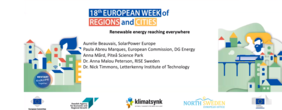Renewable energy reaching everywhere was organized on 20 October by the Swedish Agency for Economic and Regional Growth and the North Sweden European Office as part of the 18th European Week of Regions and Cities.
The webinar addressed new research on solar power and renewable energy in the Arctic with a focus on achieving climate-neutrality and featured contribution from SMARTrenew project partner, Dr Nick Timmons of the WiSAR Lab and Technology Gateway at the Letterkenny Institute of Technology in Donegal, Ireland.
The invited speakers presented several concrete examples of projects within solar power in Artic conditions.
Moderator Ms Aurélie Beauvais, Policy Director at SolarPower Europe, set the scene by stating that solar power is becoming the cheapest electricity source in history. She referred to the study “100% Renewable Europe – Harvesting the potential of solar and renewables across EU regions” and pointed to that solar power will become the number one energy source in the next five years in terms of installed capacities.
Ms Paula Abreu Marques, Head of Unit for “Renewable and CCS policy” at the European Commission’s DG Energy, gave a background on the European Green Deal and the goal of making Europe climate neutral by 2050. She specially highlighted the Strategy for Energy System Integration (ESI) and the Hydrogen Strategy as important tools.
Ms Anna Mård, Innovation Manager at Piteå Science park, gave a presentation on how Piteå Science Park works towards their goal of increased solar power investments in small and medium size companies. The city of Piteå is located close to the Artic Circle and in opposite to what some people might think, solar power works very well in northern Europe despite the many dark months of the year.
Dr Anna Malou Petersson, Director of Energy Technology at Research Institute of Sweden (RISE), gave a brief background on Sweden’s Climate Policy and the goal of reaching CO2 net emissions by 2045. RISE had a cooperation with Piteå Science Park in 2017 where they developed guidelines and best practices for solar power in northern conditions within the ERDF funded project SunCold.
Dr Nick Timmons,at Letterkenny Institute for Technology explained that the SMARTrenew project (Interreg Northern Perphet and Artic Programme) was developed to look at the challenges facing the northern periphery and Artic regions, especially exploring potential for smart energy and heat storage and the renewable mix.
Mr Iver Frimannslund, PhD student at the Norwegian University of Life Sciences and University Centre in Svalbard, gave an introduction to his work on solar power plants in polar regions. He emphasised that cold temperatures and reflections from the snow is favourable for solar panels.
Take away message Solar power can be an advantageous green energy source in Artic conditions and that a transition into renewable energy is possible in all locations.
Presentations by Paula Abreu Marques, Head of Unit ‘Renewables and CCS policy’, Directorate General for Energy Petersson Anna Malou: RISE Research Institutes of Sweden Timmons Nick: SMARTrenew Mård Anna: Artic Solar Piteå Science Park Mård Anna: SolarPower Europe

